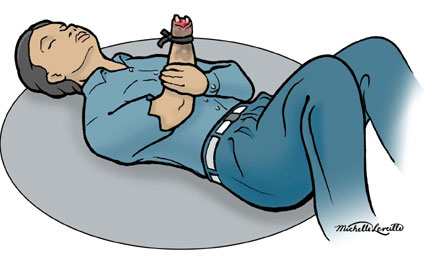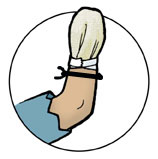

Anatomy of First Aid: A Case Study Approach
Ronald Bergman, Ph.D.
Peer Review Status: Internally Peer Reviewed
|
A Sailor aboard a destroyer in the Atlantic Ocean lost her hand in an engineering accident. A nearby Sailor called out for someone to summon the corpsman and he immediately applied a tourniquet (see section on Injury to Thigh) on the injured arm. He was able to stop the bleeding and had the Sailor lie down. She was covered with a blanket to reduce the possibility of severe shock. The Sailor also recognized the necessity to elevate her feet by about 8 to 12 inches. He remembered that shock is essentially a sudden drop in blood pressure, which may be so severe that the brain and other vital organs do not have adequate blood flow. These few, simple, things help prevent additional cardiorespiratory complications. |
|
|
|
|
|
|
 |
||
By now the corpsman arrived on the scene and took charge of first aid. He checked her vital signs (pulse rate, blood pressure, and respiratory rate), which were found to be at satisfactory and stable levels. He located the severed hand, wrapped it in sterile bandages and placed the hand in a plastic bag and then into a carrier he brought with him. It was filled with ice to chill (not freeze) the amputated part. The corpsman then returned to the patient and recorded the time of application of the tourniquet on the patient's forehead with a waterproof marker in large numbers. Ascertaining once again that the bleeding had stopped, he taped a loose, sterile, moist bandage over the stump of the forearm but was very careful not to cover the tourniquet. He then supervised the movement of the patient to his sickbay. Not equipped to handle amputations, he communicated with the medical officer on a nearby ship for further instructions. He then made preparation for ship-to-ship transfer of the injured patient.

Please send us comments by filling out our Comment Form.
All contents copyright © 1995-2025 the Author(s) and Michael P. D'Alessandro, M.D. All rights reserved.
"Anatomy Atlases", the Anatomy Atlases logo, and "A digital library of anatomy information" are all Trademarks of Michael P. D'Alessandro, M.D.
Anatomy Atlases is funded in whole by Michael P. D'Alessandro, M.D. Advertising is not accepted.
Your personal information remains confidential and is not sold, leased, or given to any third party be they reliable or not.
The information contained in Anatomy Atlases is not a substitute for the medical care and advice of your physician. There may be variations in treatment that your physician may recommend based on individual facts and circumstances.
URL: http://www.anatomyatlases.org/